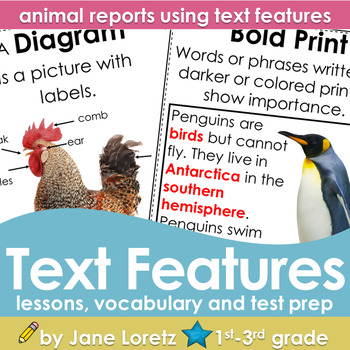Text Features (lesson,vocabulary, test prep, animal reports using text features)
- PDF
What educators are saying
Description
Text features are fun to learn with this unit!
This pack is filled with effective lessons for teaching nonfiction text features.
Your students will understand the terms that go with informational or nonfiction texts.
Your students will create their own animal report using text features in their report.
The entire report is first modeled using the example included. All materials included for a great report.
This unit on text features first starts out with the teacher using the gradual release of responsibility model of instruction while making a Nonfiction Text Features Booklet.
The gradual release of responsibility model….
(I do it)
(We do it)
Then (You do it!)
The first page of the booklet has the text feature, definition and an example. You may want to post them or keep them in the booklet. This is the (I do it.)
The second page has the text feature and definition and is specific on what type of example to put on the page, this can be done together. (We do it.)
The third page of the booklet has the text feature, definition but the students will make their example on their own. This can be done when using a text that has these features or making one up on their own. (You do it)
The booklet can be bound together to show how the students learned about text features and is a nice resource to use at any time.
Also included in this pack.
A Quiz on the Research process-That is the term I have seen used on practice common core standardized tests that deal with nonfiction and informational texts. Format similar to sample tests.
-Common core standards that this lesson aligns with.
-25 Vocabulary words that deal with informational text and are all considered to be academic vocabulary words that students need taught and learned for success in school. These words would look great in a pocket chart, displayed and reviewed often. *Print these pages on cardstock for durability.
-Planning sheets that go with writing informational texts, and their animal reports.
-An ABC order sheet to practice putting the vocabulary words in ABC order.
-Locating text features in books printable.
This is a complete pack and will have your students understanding text features and informational text better,
This unit meets common core standards and is a fun way for your students to learn and create their own books.
Happy teaching and enjoy! Jane Loretz





